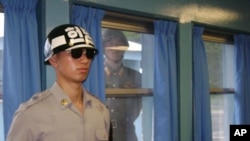The U.S. secretaries of State and Defense made an unprecedented joint visit to the Korean demilitarized zone, Wednesday morning, in a show of solidarity with South Korea. The visit by Secretary of State Hillary Clinton and Secretary of Defense Robert Gates came in the wake of the sinking of a South Korean Navy ship by North Korea and just a few days before the first of several large scale military exercises in the area designed to send a message of strength and resolve to the North.
U.S. Army Sergeant Cory Strickland acts as tour guide for a group of reporters heading into the zone with Secretary Gates. Here, security is a priority.
"Well, you know we just have to pay particular attention, you know, because we're, like, in the world's eye being up here on the front line, pretty much," said Strickland. "You know, I believe if North Korea wanted to make a statement, this would probably be the place to do it."
This is among the last vestiges of the Cold War, a heavily defended five-kilometer-wide buffer zone between two countries with the same language and culture, but starkly different societies.
It was Secretary Clinton's first visit to the zone.
"Although it may be a thin line, these two places are worlds apart," said Clinton.
Standing just a few meters from the Armistice Line, with North Korea as a backdrop, Clinton and Gates both spoke of the strong alliance between the United States and South Korea, and the U.S. commitment to help defend the South. The demilitarized zone is a symbol of the ongoing confrontation with North Korea, heightened by the ship sinking, but Secretary Clinton said that does not have to continue.
"There is a better way," she said. "There is a way that can benefit the people of the North. But until they change direction, the United States stands firmly on behalf of the people and government of the Republic of Korea."
So far, the Obama administration's efforts to use multilateral diplomacy to end North Korea's nuclear weapons program and moderate its behavior have not been successful.
Secretaries Gates and Clinton entered the negotiation building that straddles the demarcation line and crossed briefly to the North Korean side as they were shown around. A North Korean soldier stared at them from just a few centimeters away, through a window.
The joint visit comes four months after the sinking of the South Korean Navy ship, Cheonan, which killed 46 sailors on board. An international investigation concluded that a North Korean torpedo sank the ship, but North Korea denies the charge. On Tuesday, the United States and South Korea formally announced a series of joint military exercises, starting this Sunday, as a show of solidarity and a warning to North Korea against making any further such attacks.
Secretary Gates referred to the attack in his statement at the DMZ.
"Looking out across the DMZ, it is stunning how little has changed in the North and yet how much South Korea has continued to grow and prosper," said Secretary Gates. "The North, by contrast, stagnates in isolation and depravation. And, as we saw with the sinking of the Cheonan, it continues its history of unpredictable and, at times, provocative behavior."
Secretaries Gates and Clinton went from the demilitarized zone to the Korean War Memorial in Seoul, less than an hour away by road. They paid their respects to the dead from all of South Korea's wars and stopped at a plaque bearing the names of the sailors who were on board the Cheonan. The brief ceremony was part of the commemoration of the 60th anniversary of the start of the Korean War.
The secretaries also met with their South Korean counterparts for the first-ever such joint meeting for the two countries. To emphasize the seriousness with which the United States is taking the Cheonan incident, the American cabinet members were accompanied by a high-level civilian and military delegation, including the top U.S. military officer, Admiral Mike Mullen, and the commander of U.S. forces in the Pacific, Admiral Robert Willard.






